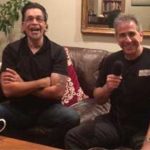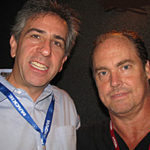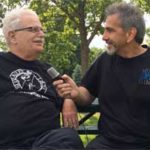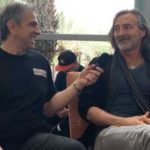Late-night TV bassist and LA session player talks to FBPO about his new CD release, equipment, gigs and more
Exclusive interview with FBPO’s Jon Liebman
July 7, 2014
Jimmy Earl has worked professionally in Boston, New York and Los Angeles after attending Berklee College of Music and the New England Conservatory of Music. Over the course of his decades-long career, Earl has performed with Gato Barbieri, Angela Bofill, Tom Browne, Chick Corea, George Duke, Freddie Hubbard, Stanley Turrentine and many others. He has also toured with the Crusaders, Robben Ford and Stanley Clarke and has appeared on Clarke’s If This Bass Could Only Talk and East River Drive albums.
Since 2003, Jimmy has held down the bass chair with Cleto and the Cletones, the house band for the Jimmy Kimmel Live show. He can also be seen frequently at the famed Baked Potato club in Studio City, CA, where he has performed with the likes of Dean Brown, Deron Johnson, Scott Kinsey, Simon Phillips, Jeff Richman, Steve Tavaglione and Steve Weingart.
FBPO’s Jon Liebman caught up with Jimmy to talk about his latest release, Renewing Disguises.
FBPO: It’s been a while since you released a solo project. What was the thinking behind Renewing Disguises? Was there a message you wanted to get across?
JE: It has actually been sixteen years since I released my last solo CD, Stratosphere, in 1998. These tracks on Renewing Disguises started as electronic sketches that ended up a combination of real playing and electronic sounds. There was no message, just me messing around with computers and software.
FBPO: A lot of the album sounds like a nod to Miles, especially your version of the Miles Davis/Gil Evans collaboration, “Gone.” There seems to be a fair bit of that characteristic trumpet sound and certain electronic “feels” throughout the record. Am I right?
JE: I have been a fan of Miles Davis’ music for as long as I can remember. “Gone” started off as a remix exercise in tempo mapping. Tempo mapping is a process where you instruct the computer to follow along with a pre-recorded track. After I had it tempo mapped, I auditioned drumbeats and added my bass. An ’80s-sounding Virus synth bass part was added during the trumpet solo, along with drum ‘n’ bass beats. I played a double time walking bass through the solo section also.
When the first draft was complete, I sent a demo to Miles Davis’ management that they thought was cool, but one of Miles’ relatives did not want Miles to be on it. I found a copy of the big band score from Ken Shaphorst, head of The New England Conservatory jazz department, and went about redoing the big band. Scott Kinsey suggested that we call Tim Hagans in New York to play the lead trumpet part. We arranged a recording session at Matt Garrison’s Shapeshifter Labs in Brooklyn, New York, for Tim to put his trumpet on. Matt produced the session. Tim sounded so great that we asked him to play on several tracks during that session. Scott played the rest of the big-band instruments and Rick Baptist played the big band trumpet section. Gary Novak played drums. It was a blessing to redo the original track because what we ended up with is so much better. Thanks to Scott Kinsey for these decisions.
See our first interview with Jimmy, as well as our exclusive
FBPO interview with Matt Garrison, who is also mentioned here:
[table id=79 /]
FBPO: The Miles reference is apparent right from the beginning, with “Africano Cento Cinquanta,” which also has a few different grooves and feel changes.
JE: “Africano Cento Cinquanta” actually means African 150. 150 is the beats-per-minute of the piece. “African 150” has been the working title for many years, so I just used the Italian translation. I like the instrumentation the melody has, the vibraphone doubled with theremin and muted trumpet. The theremin was used for spooky sounds in movies from the ’50s and ’60s. I first heard this combination in music from the original American gothic soap opera Dark Shadows. I would say it is a more jazz-funk tune than an African piece. The kora gives it the African flavor. The reprise serves the same purpose as music played behind the final credits in a film. It makes the whole CD sound more complete.
FBPO: I love the sound and feel of “Old Jazz,” including the prominence of the drums and percussion, along with the Rhodes. I’m sensing there’s some meaning behind the tune, especially with the (ultra hip) “Jazz!” utterances throughout! Whose voice is that, by the way?
JE: “Old Jazz” is one of the sketches I have had kicking around in my computer’s hard drive for many years. It has a strong bass line and a fat groove. It needs no melody. The groove says it all. It has an abrupt tempo change in the middle, with great performances from Gary Novak and Lenny Castro. Also, an incredible Fender Rhodes piano solo from Scott Kinsey. The “Jazz” voice is a sample that I found from the Internet. I have no idea whose voice it is. I came up with the bass line by jamming along with the track and looping a 4-bar section.
FBPO: While there’s a lot of truly great bass playing throughout, it doesn’t really sound like a “bass record.” Was that on purpose?
JE: Thanks! I would say that it just turned out that way. I didn’t want to use the bass too much on melodies. I wanted to use it mainly for the groove parts and keep it in the rhythm section.
FBPO: I know what you mean. In several instances, like on “Old Jazz” and “Night,” most of the groove is carried by the drums and percussion.
JE: “Night” is a remix of the third movement of Sergei Prokofiev’s “Scythian Suite.” The atmospheric passage with the flutes is the only part from the original composition. The rest is a result of throwing in a lot of ideas to see what worked and growing the track from there. The drum ‘n’ bass breaks worked well with the Prokofiev passage because of the stark contrast. I have been a fan of drum ‘n’ bass since I first heard the idiom when I was on tour with Pino Daniele in Italy in 1996. Gary Novak and Lenny Castro played along with the original drum and percussion loops on these tracks. We used all the loops and the real drums and percussion. Their time is so spot on that it is hard to tell the difference. Steve Tavaglione played flutes and saxophone. The acoustic bass was the last thing to be recorded. I played my Chinese Roggeri (copy) acoustic bass and my Warwick Dolphin fretless bass at the end.
FBPO: The spoken words in “Night” and “Mr. Thumpy” reminded me a little of a ’60s sci-fi movie or more of the Dark Shadows sound. Was that the mood you were going for?
JE: I like electronic music that has humor in it. I try to keep the fun element when using electronics. Sometimes when electronic music gets too serious, it ends up hard to listen to. The stupid sci-fi dialog samples, I hope, help to keep these tracks humorous.
FBPO: “Cavatina” offers up a real change of pace. There’s some beautiful fretless bass playing on that tune. And is that you on the acoustic guitar?
JE: Thanks again! “Cavatina” is the theme from the 1978 film The Deer Hunter, composed by Stanley Myers. The melody is stunningly beautiful. It is a perfect piece for working on playing melodies on the bass. I took the original recording from the film The Deer Hunter, tempo-mapped it and re-created the accompaniment using synths and pads. After working on it, we decided to call my good friend and Chick Corea Elektric Band II band mate Mike Miller on acoustic nylon string guitar instead of using the synths by themselves. If you listen closely you can hear the synths faintly.
FBPO: There’s a nice back and forth sequence between the percussion-infused louder tunes and the quiet, easier tunes. “Ambient” is another case in point, with its quasi “New Age” type of sound.
JE: “Ambient” is a little piece to break up the sequence of music on the CD. It is used as a “rest for the ears.” I really enjoy Brian Eno’s ambient music.
FBPO: Tell me about the title tune. I love the “call and response” section, with the horns trading off against a jagged “tongue twister” line throughout.
JE: “Renewing Disguises” is a piece written by film composer David Shire for the 1974 film The Taking Pelham, 123. Originally, it was a short two-minute piece. I rearranged the musical elements and spread them out over the course of about four minutes. I transcribed the orchestra phrases and re-recorded them using software. Steve Tavaglione tried different instruments and approaches and we settled on the alto sax solo. I love the NYC “Loft Jazz” approach he took.
FBPO: How about “Weather Reporting”? The reference there is none too subtle! Great bass playing, by the way!
JE: “Weather Reporting” is a track that I hope captures a similar vibe to the early Weather Report recordings. I used the same melody instrumentation as “Africano Cento Cinquanta,” with vibraphone and theremin. Steve Tavaglione played the sax solo. Gary Novak and Lenny Castro played incredible drums and percussion. An interesting thing about this piece, and everything on the project, is that no one played at the same time. Everyone was overdubbed, yet we accomplished a “played live” feeling. I used my Warwick Stage Two Streamer 4-string on this track.
FBPO: You’ve got some long-established studio veterans in the band, like Gary Novak, Steve Tavaglione and Lenny Castro. How did you decide whom to use on the record?
JE: Most of the musicians I have known for many years. Percussionist Lenny Castro and I know each other from playing with the Crusaders in the mid ’80s and from many different local Los Angeles groups and recording sessions. He is great to work with. Gary Novak, Mike Miller and I were in Chick Corea’s Elektric Band II together. We made an album and toured the world in 1994-1995. We also play together at the Baked Potato in LA all the time with various groups. Scott Kinsey and I have known each other for almost two decades now. We had a group that played every Wednesday night for quite a few years at a local LA jazz club called La Vee Lee. Scott Henderson played along with reedman Steve Tavaglione and drummers Gary Novak and Kirk Covington. Lately, we have been playing monthly at the Baked Potato club in LA.
Scott Kinsey is a true creative spirit. I’ve known Steve Tavaglione for almost twenty-five years. We first worked together on Truth in Shredding and have been doing various gigs and recordings ever since. I love how he played the alto saxophone on “Renewing Disguises.” Tim Hagans and I worked together with Scott Kinsey’s group at La Vee Lee when Tim would come to town. Incredible player.
FBPO: Tell me about your equipment. What did you use on the recording?
JE: I play Fender and Warwick basses on the CD. A 1966 Olympic white Fender Jazz bass with a maple-cap neck, a 1972 black Fender Jazz bass with a maple neck, a Warwick Streamer Stage Two four-string and a Warwick Dolphin Fretless four-string. I mainly play 4-string basses now. If I need to use a five-string, I’ll use my signature Warwick Streamer LX. Great-sounding five-string.
I use a Gallien-Krueger an 800RB bass amp with a Gallien-Krueger 2×12 Neo Cabinet. I also use Dean Markley SR2000 ML bass strings. The thing I like best about the SR2000s is that they last longer than other bass guitar strings I have used.
FBPO: What else is keeping you busy these days?
JE: Jimmy Kimmel Live keeps me pretty busy. I don’t travel much. The show finishes around 7:00 p.m., so I’m able to do local club gigs afterwards. These gigs are a lot of fun and they help me stretch out and keep my chops up. I’ll sometimes do a festival or gig out of town on weekends every so often. I’m also studying classical piano. I never realized how difficult piano is. It really helps my reading on the bass.
FBPO: What lies ahead?
JE: Maybe a solo bass project? We’ll see.
To purchase Jimmy’s latest release, Renewing Disguises, click here.

![]()









